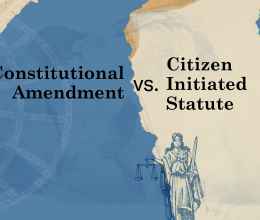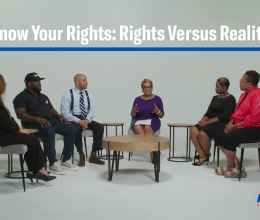Several weeks ago, I had the opportunity to visit the Cuyahoga County Common Pleas Drug Court with fellow ACLU intern, Kyra Schoonover. It certainly was an eye-opening experience for both of us.
How It Works
Before the proceedings began, we met with the judge. He explained that drug court is an alternative-sentencing program where low-level drug offenders can have their sentences vacated or expunged if they successfully complete court ordered meetings, drug rehabilitation treatment, random drug tests, and appear before a judge to check on their progress. Although they vary according to state and local guidelines, participants usually stay in the program for a minimum of one year.
Currently, Ohio has 35 adult and 26 juvenile drug courts.
Why It Works
The purpose of drug court is to break the cycle of recidivism, or the possibility that a person relapses into criminal behavior, after receiving intervention. Research shows that drug courts are effective: Nationwide, 75 percent of drug courts graduates are arrest-free for at least two years after leaving the program; and, drug courts have been found to reduce crime as much as 45 percent more than other sentencing programs.
For participants, respecting oneself is a key element of succeeding in drug court. I distinctly remember the hearing of one woman who started using heroin again with her boyfriend. The judge told her that she was worth more than she believed and until she understood her value as a human being, she could not help herself.
Another important goal is accountability. Drug courts provide jurisdictions with the opportunity to infuse accountability into rehabilitative treatment to increase the personal, familial, and societal accountability of drug offenders.
Rehabilitation is an incredibly hard feat. People with criminal convictions can’t find the proper resources for treatment in prisons, so alternative-sentencing programs are an improvement from incarceration. According to a report from Case Western Reserve University, in the Cuyahoga Common Pleas Drug Court, 8.4 percent of the drug court group were re-arrested for misdemeanor and felony charges within 12 months of being discharged, compared to 27 percent of a control group. Thus, drug court has the potential to change the path of mass incarceration and benefit those who graduate from the program, if it is accessible to all.
What Needs to Change
Please take a look at the ACLU of Ohio’s publication, “Overcharging, Overspending, Overlooking: Cuyahoga County’s Costly War on Drugs.”
One problem I noticed was the lack of inclusion in the courtroom. Anecdotally, I saw about 25 participants of drug court that morning, and there was only one person who was not white. Because African-Americans use drugs at almost the same rate as white people, and are searched and frisked at higher rates, one would assume that the majority of Cuyahoga County’s Drug Court participants would be African-American.
Unfortunately, attorneys can be biased in recommending African- Americans to drug court. According to a 2014 Ohio Department of Rehabilitation and Correction report, prison diversion programs were 59 percent Caucasian and 38 percent African-American and jail diversion programs were 70 percent Caucasian and just under 27 percent African-American. Moreover, black participants are at least 30 percent more likely than white participants to be expelled from drug court. This can be attributed to the lack of culturally appropriate treatment programs and very few counselors of color in drug court.
If drug court hopes to be an effective alternative-sentencing program, it cannot afford to be guilty of systemic racial biasing. For far too long, our criminal justice system has perpetuated the stereotypes of African-Americans as the majority of criminals in our nation, which is not true. I hope that alternative-sentencing programs like drug courts can be accessible to all in order to change the inequality that still exists today.
Lauren Hawkes is an intern at the ACLU of Ohio.








